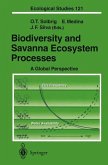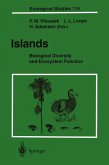- Broschiertes Buch
- Merkliste
- Auf die Merkliste
- Bewerten Bewerten
- Teilen
- Produkt teilen
- Produkterinnerung
- Produkterinnerung
Der Schwund an biologischer Vielfalt (Biodiversität) durch die Zerstörung von Ökosystemen und die Ausrottung von Tier- und Pflanzenarten hat bedrohliche und zum Teil noch unübersehbare Folgen. Wissenschaftler aus den Bereichen Ökologie und Populationsbiologie untersuchen die verschiedensten Aspekte dieses Themas.
Andere Kunden interessierten sich auch für
![Biodiversity and Savanna Ecosystem Processes Biodiversity and Savanna Ecosystem Processes]() Biodiversity and Savanna Ecosystem Processes77,99 €
Biodiversity and Savanna Ecosystem Processes77,99 €![Arctic and Alpine Biodiversity: Patterns, Causes and Ecosystem Consequences Arctic and Alpine Biodiversity: Patterns, Causes and Ecosystem Consequences]() Arctic and Alpine Biodiversity: Patterns, Causes and Ecosystem Consequences76,99 €
Arctic and Alpine Biodiversity: Patterns, Causes and Ecosystem Consequences76,99 €![Marine Biodiversity Marine Biodiversity]() H. Queiroga (Volume ed.) / M.R. Cunha / A. Cunha / M.H. Moreira / V. Quintino / A.M. Rodrigues / J. Serôdio / R.M. WarwickMarine Biodiversity116,99 €
H. Queiroga (Volume ed.) / M.R. Cunha / A. Cunha / M.H. Moreira / V. Quintino / A.M. Rodrigues / J. Serôdio / R.M. WarwickMarine Biodiversity116,99 €![Biodiversität - Warum wir ohne Vielfalt nicht leben können Biodiversität - Warum wir ohne Vielfalt nicht leben können]() Ewald WeberBiodiversität - Warum wir ohne Vielfalt nicht leben können24,99 €
Ewald WeberBiodiversität - Warum wir ohne Vielfalt nicht leben können24,99 €![Islands Islands]() Islands77,99 €
Islands77,99 €![Biodiversity and Ecosystem Processes in Tropical Forests Biodiversity and Ecosystem Processes in Tropical Forests]() Biodiversity and Ecosystem Processes in Tropical Forests115,99 €
Biodiversity and Ecosystem Processes in Tropical Forests115,99 €![Biologische Vielfalt Perspektiven für das Neue Jahrhundert Biologische Vielfalt Perspektiven für das Neue Jahrhundert]() Gregor KlausBiologische Vielfalt Perspektiven für das Neue Jahrhundert49,99 €
Gregor KlausBiologische Vielfalt Perspektiven für das Neue Jahrhundert49,99 €-
-
-
Der Schwund an biologischer Vielfalt (Biodiversität) durch die Zerstörung von Ökosystemen und die Ausrottung von Tier- und Pflanzenarten hat bedrohliche und zum Teil noch unübersehbare Folgen. Wissenschaftler aus den Bereichen Ökologie und Populationsbiologie untersuchen die verschiedensten Aspekte dieses Themas.
Produktdetails
- Produktdetails
- Springer Study Edition
- Verlag: Springer / Springer Berlin Heidelberg / Springer, Berlin
- Artikelnr. des Verlages: 978-3-540-58103-1
- 1993.
- Seitenzahl: 556
- Erscheinungstermin: 26. Juli 1994
- Englisch
- Abmessung: 235mm x 155mm x 30mm
- Gewicht: 836g
- ISBN-13: 9783540581031
- ISBN-10: 3540581030
- Artikelnr.: 26246711
- Herstellerkennzeichnung
- Springer-Verlag GmbH
- Tiergartenstr. 17
- 69121 Heidelberg
- ProductSafety@springernature.com
- Springer Study Edition
- Verlag: Springer / Springer Berlin Heidelberg / Springer, Berlin
- Artikelnr. des Verlages: 978-3-540-58103-1
- 1993.
- Seitenzahl: 556
- Erscheinungstermin: 26. Juli 1994
- Englisch
- Abmessung: 235mm x 155mm x 30mm
- Gewicht: 836g
- ISBN-13: 9783540581031
- ISBN-10: 3540581030
- Artikelnr.: 26246711
- Herstellerkennzeichnung
- Springer-Verlag GmbH
- Tiergartenstr. 17
- 69121 Heidelberg
- ProductSafety@springernature.com
Section A: Ecosystem Function.- 1 Biological Diversity and Terrestrial Ecosystem Biogeochemistry.- 2 Biodiversity and Ecosystem Function in Agricultural Systems.- 3 Biodiversity and Interactions Within Pelagic Nutrient Cycling and Productivity.- Section B: Functional Groups.- 4 Functional Groups of Microorganisms.- 5 Plant Traits and Adaptive Strategies: Their Role in Ecosystem Function.- 6 Scaling from Species to Vegetation: The Usefulness of Functional Groups.- Section C: Species Interaction.- 7 Evolution of Functional Groups in Basidiomycetes (Fungi).- 8 The Role of Parasites in Plant Populations and Communities.- 9 Plant-Microbe Mutualisms and Community Structure.- 10 The Evolution of Interactions and Diversity in Plant- Insect Systems: The Urophora-Eurytoma Food Web in Galls on Palearctic Cardueae.- Section D: Community Interactions.- 11 Keystone Species.- 12 Redundancy in Ecosystems.- 13 How Many Species Are Required for a Functional Ecosystem?.- 14 Rare and Common Plants in Ecosystems, with Special Reference to the South-west Australian Flora.- 15 Community Diversity and Succession: The Roles of Competition, Dispersal, and Habitat Modification.- Section E: Ecosystem Integrity.- 16 Biodiversity and the Balance of Nature.- 17 Biodiversity and Function of Grazing Ecosystems.- 18 Resource Supply and Disturbance as Controls over Present and Future Plant Diversity.- 19 Ecosystem Stability, Competition, and Nutrient Cycling.- 20 Modelling Biodiversity: Latitudinal Gradient of Forest Species Diversity.- 21 Functional Aspects of Landscape Diversity: A Bavarian Example.- Section F: Industrial Analogy and Policy.- 22 Biodiversity Issues in Computing: A Study of Networked Computer Viruses.- 23 Biodiversity and Policy Decisions.- 24 Ecosystem Function of Biodiversity: A Summary.- Species Index.
Section A: Ecosystem Function.- 1 Biological Diversity and Terrestrial Ecosystem Biogeochemistry.- 2 Biodiversity and Ecosystem Function in Agricultural Systems.- 3 Biodiversity and Interactions Within Pelagic Nutrient Cycling and Productivity.- Section B: Functional Groups.- 4 Functional Groups of Microorganisms.- 5 Plant Traits and Adaptive Strategies: Their Role in Ecosystem Function.- 6 Scaling from Species to Vegetation: The Usefulness of Functional Groups.- Section C: Species Interaction.- 7 Evolution of Functional Groups in Basidiomycetes (Fungi).- 8 The Role of Parasites in Plant Populations and Communities.- 9 Plant-Microbe Mutualisms and Community Structure.- 10 The Evolution of Interactions and Diversity in Plant- Insect Systems: The Urophora-Eurytoma Food Web in Galls on Palearctic Cardueae.- Section D: Community Interactions.- 11 Keystone Species.- 12 Redundancy in Ecosystems.- 13 How Many Species Are Required for a Functional Ecosystem?.- 14 Rare and Common Plants in Ecosystems, with Special Reference to the South-west Australian Flora.- 15 Community Diversity and Succession: The Roles of Competition, Dispersal, and Habitat Modification.- Section E: Ecosystem Integrity.- 16 Biodiversity and the Balance of Nature.- 17 Biodiversity and Function of Grazing Ecosystems.- 18 Resource Supply and Disturbance as Controls over Present and Future Plant Diversity.- 19 Ecosystem Stability, Competition, and Nutrient Cycling.- 20 Modelling Biodiversity: Latitudinal Gradient of Forest Species Diversity.- 21 Functional Aspects of Landscape Diversity: A Bavarian Example.- Section F: Industrial Analogy and Policy.- 22 Biodiversity Issues in Computing: A Study of Networked Computer Viruses.- 23 Biodiversity and Policy Decisions.- 24 Ecosystem Function of Biodiversity: A Summary.- Species Index.









